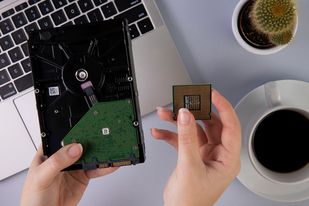If you are wondering why ROM is called the Non Volatile Memory? Then, this article will clear all your doubts and queries pretty easily.
ROM is non-volatile memory, which means that the data stays on the chip all the time. The memory doesn’t need an electric current to store information; instead, binary code is used to write information to each cell. Non-volatile memory is used for parts of the computer that don’t change, like the part of the software that runs when the computer first starts up or the firmware instructions that make your printer work.
ROM doesn’t change when you turn off the computer. In other words you can not change a non-volatile memory if you want to. With that lets start with the article and know why do we call the ROM a non volatile memory.
ROM The Non Volatile Memory
Keep reading this article as we have cleared all the aspects covering the Safe ROM Sites as well as the reasons behind ROM known as the Non Volatile Memory.
Reasons Behind ROM Being Non Volatile
Check out the different reasons why the term Non Volatile describes the Random Access Memeory:
Permanent Data Storage
When the power goes off, data in volatile memory is lost, but in ROM, it stays even when the machine is off. Since these instructions must be accessible at system startup, ROM is a great option for storing them.
Data Retention
The information contained inside ROM stays intact throughout the lifecycle of the machine because ROM preserves data integrity over lengthy durations. The integrity of fundamental system-level instructions, such as the Basic Input/Output System (BIOS) or firmware configurations, depends on this dependability.
Limited Write Capabilities
When compared to other memory types, ROM’s write capabilities are very lacking or nonexistent. No amount of conventional computer operations can change or delete the data written into ROM during production; this data is permanent. Because of its read-only attribute, the data saved cannot be altered or corrupted by mistake.
Importance in Booting Process
The read-only memory (ROM) is an essential component of a computer since it stores the basic startup instructions. It includes the software that loads the operating system, initializes hardware components and runs self-tests. Because read-only memory (ROM) is not impacted by power cycles, these instructions are always available.
Benefits Of Using A High Speed ROM In Your Computer
Here are some of the advantages that you can get if you use the best ROM in your computer.
Data Persistence: Data is stored in ROM even when power is off, guaranteeing that crucial instructions are always accessible.
Reliability: As ROM is permanent and cannot be changed, the system behaves consistently and predictably.
Security: Data is protected from unwanted alterations or manipulation by virtue of ROM’s read-only nature.
Instant Access: There is no startup delay while accessing data stored in ROM.
Cost-Effectiveness: Since ROM is nonvolatility, it does not need any extra power or backup systems.
Immunity to Data Loss: Because ROM cannot be damaged or rewritten, important data is protected.
Read Me: Overseeing Distant Teams? Nine Difficulties and Their Solutions
Types Of ROM
Below are all the available types of ROM that you can get from the current market.
Masked read-only memory (MROM)
As far back as semiconductor technology goes, we know that ROM exists. The first random-access memory (ROM) used transistor switches to connect a grid of word and bit lines; this design was known as MROM. Only during manufacture can this form of ROM data be programmed; it is physically recorded in the circuit. The price was reasonable.
Programmable read-only memory (PROM)
EEPROMs are digital memories. Each bit in this ROM type is protected by an anti-fuse or fuse. Its contents are immutable and cannot be deleted or altered. It finds its place in microcode and firmware, two examples of low-level programming.
Erasable programmable read-only memory (EPROM)
One form of PROM that may be reprogrammed is EPROM, which is also known as EROM. With the use of UV light, EPROMs may have their data wiped and reprogrammed. You can only reprogram so much of it. Microcontrollers used EPROM prior to the advent of EEPROM and flash memory.
Electrically erasable programmable read-only memory (EEPROM)
Its name implies that it may be electrically programmed and wiped. This ROM’s data and software can be deleted and reprogrammed about 10,000 times. Erasing and programming an EEPROM takes around 4 to 10 milliseconds. Microcontrollers and remote keyless systems take advantage of it.
Wrapping Up
ROM is properly called ‘nonvolatile memory’ because it can store data forever, even when it’s not being powered on all the time. Because it can only be read and stores important information, it is an important part of computer systems. Understanding the idea of nonvolatile memory and what it means in computer design helps us understand how important ROM is for making sure that systems work reliably and consistently. For more insights on technology and related topics, check out RedGIF.
